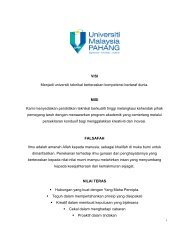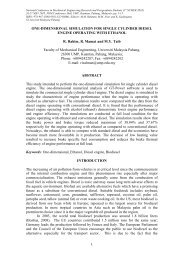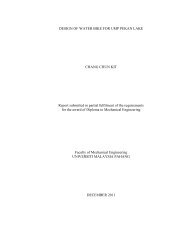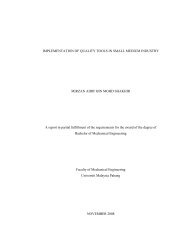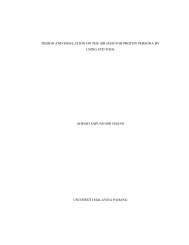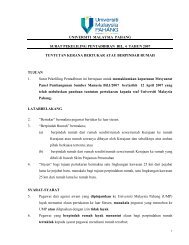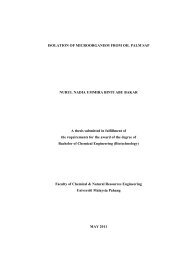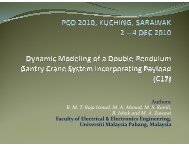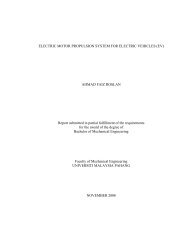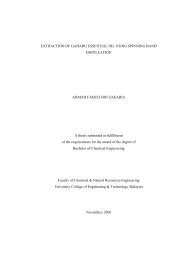effect of ammonia/water ratio in the perfomance absorption chiller ...
effect of ammonia/water ratio in the perfomance absorption chiller ...
effect of ammonia/water ratio in the perfomance absorption chiller ...
Create successful ePaper yourself
Turn your PDF publications into a flip-book with our unique Google optimized e-Paper software.
“I declare that I have read this <strong>the</strong>sis and <strong>in</strong> my op<strong>in</strong>ion this <strong>the</strong>sis is adequate <strong>in</strong> terms<strong>of</strong> scope and quality for <strong>the</strong> purpose award<strong>in</strong>g a Bachelor’s Degree <strong>of</strong> ChemicalEng<strong>in</strong>eer<strong>in</strong>g (Gas Technology).”Signature : ........................................................Supervisor’s Name : Associate Pr<strong>of</strong>essor Zulkafli B<strong>in</strong> HassanDate : ...........................................................
iEFFECT OF AMMONIA/WATER RATIO IN THE PERFOMANCEABSORPTION CHILLERKAMARUL ARIFFIN BIN IDRISA <strong>the</strong>sis submitted <strong>in</strong> fulfilment <strong>of</strong> <strong>the</strong>Requirement for <strong>the</strong> award <strong>of</strong> <strong>the</strong> degree <strong>of</strong>Bachelor <strong>of</strong> Chemical Eng<strong>in</strong>eer<strong>in</strong>g(Gas Technology)Faculty <strong>of</strong> Chemical and Natural Resources Eng<strong>in</strong>eer<strong>in</strong>gUniversity Malaysia Pahang (UMP)MAY, 2008
iiI declare that this <strong>the</strong>sis entitled ‘Effect <strong>of</strong> <strong>ammonia</strong>/<strong>water</strong> <strong>ratio</strong> <strong>in</strong> <strong>the</strong> performance<strong>absorption</strong> <strong>chiller</strong>s’ is <strong>the</strong> results <strong>of</strong> my own research except as cited <strong>in</strong> <strong>the</strong> references.The <strong>the</strong>sis has not been accepted for any degree and is not concurrently submittedcandidature <strong>of</strong> any o<strong>the</strong>r degree.Signature : ………………………………………Name : Kamarul Ariff<strong>in</strong> B<strong>in</strong> IdrisDate : 16 May 2008
ivACKNOWLEDGEMENTI owe this <strong>the</strong>sis to a number <strong>of</strong> people who has contributed directly and<strong>in</strong>directly to <strong>the</strong> successful completion <strong>of</strong> <strong>the</strong> <strong>the</strong>sis. Firstly, I would like to thank mysupervisor, Associate Pr<strong>of</strong>essor Zulkafli B<strong>in</strong> Hassan for giv<strong>in</strong>g me <strong>the</strong> opportunity towork on this <strong>in</strong>terest<strong>in</strong>g project. Their many words <strong>of</strong> wisdom, scientific <strong>in</strong>sight andshape criticism, and high ethical standards are especially valuable for <strong>the</strong> implementation<strong>of</strong> this work. I am also grateful for <strong>the</strong>ir patience <strong>in</strong> correct<strong>in</strong>g my <strong>the</strong>sis and for keep<strong>in</strong>g<strong>the</strong> pressure on me to f<strong>in</strong>ish <strong>the</strong> <strong>the</strong>sis with<strong>in</strong> <strong>the</strong> time frame.Fur<strong>the</strong>r gratitude goes to all our FKKSA lecturers and staff who <strong>of</strong>fer tips, adviceand endless coope<strong>ratio</strong>n <strong>in</strong> this project. To who was <strong>in</strong>volved, you all deserved a s<strong>in</strong>cereThank You from me. My fellow postgraduate students should also be recognized for <strong>the</strong>irsupport. My s<strong>in</strong>cere appreciation also extends to all my colleagues and o<strong>the</strong>rs who haveprovided assistance at various occasions. Their views and tips are useful <strong>in</strong>deed.Unfortunately, it is not possible to list all <strong>of</strong> <strong>the</strong>m <strong>in</strong> this limited space. I am grateful toall my family members.
viii2.3 Refrigerant and absorber study 102.4 Application 123 ABSORPTION CHILLER SYSTEMS3.1 Background 143.2 General description 153.3 Type <strong>of</strong> <strong>absorption</strong> <strong>chiller</strong>s 172.3.1 Double <strong>effect</strong> <strong>absorption</strong> <strong>chiller</strong>s 172.3.2 Triple <strong>effect</strong> <strong>absorption</strong> <strong>chiller</strong>s 192.3.3 Hybrid system <strong>absorption</strong> <strong>chiller</strong>s 203.4 Lithium bromide/<strong>water</strong> <strong>absorption</strong> <strong>chiller</strong> 203.5 Ammonia/<strong>water</strong> <strong>absorption</strong> <strong>chiller</strong> 223.5.1 Availability and cost<strong>in</strong>g 223.5.2 Thermodynamic properties 233.5.3 Heat transfer coefficient (W/m.K) 233.5.4 Advantages <strong>of</strong> <strong>the</strong> system 243.5.5 Disadvantages <strong>of</strong> <strong>the</strong> system 263.6 The previous work <strong>in</strong> improv<strong>in</strong>g COP for 26<strong>absorption</strong> <strong>chiller</strong> unit3.6.1 Heat <strong>in</strong>teg<strong>ratio</strong>n 273.6.2 Additive 273.6.3 Solar Application 273.7 Environmental issues 283.8 Efficiency 304 METHODOLOGY4.1 Introduction 324.2 Overall experimental work 324.3 Sample prepa<strong>ratio</strong>n 344.4 Purg<strong>in</strong>g and refill<strong>in</strong>g procedures 344.5 Experimental procedures 38
ix4.5.1 Start-Up Procedures 384.5.2 Troubleshoot<strong>in</strong>g procedures 394.5.3 Shut-Off Procedures 394.5.4 Ma<strong>in</strong>tenance Procedures 394.5.5 Data collection 404.6 Method <strong>of</strong> analysis 425 RESULTS AND DISCUSSION5.1 Result 435.2 Discussion 466 CONCLUSION AND RECOMMENDATION6.1 Conclusion 486.2 Recommendation 49REFERENCES 50-53Appendices 54-68
xLIST OF SYMBOLSg - GramL - Litersml - MillilitersQ - Heat transferS.G. - Standard gravityT - TemperatureW - Workη - Efficiency
xiLIST OF ABBREVIATIONCOP - Coefficient <strong>of</strong> performanceCFC - Chlor<strong>of</strong>luorocarbonCHP - Comb<strong>in</strong>e Heat PowerDCC - Double condenser coupleHFMAE - Hollow fiber membranes absorber heat exchangerPHEFFA - Plate heat exchanger fall<strong>in</strong>g film type absorberDACM - Diffusion <strong>absorption</strong> cool<strong>in</strong>g mach<strong>in</strong>eVAR - Vapor <strong>absorption</strong> refrige<strong>ratio</strong>nCGS - Co-gene<strong>ratio</strong>n systemsHFC - Hydro fluorocarbonsHCFC - Hydro chlor<strong>of</strong>luorocarbonsODP - Ozone deplet<strong>in</strong>g potentialGWP - Global warm<strong>in</strong>g potential
xiiLIST OF FIGUREFIGURE NO. TITLE PAGE3.1 Faraday’s experimental apparatus 153.2 Process flow diagram for <strong>the</strong> gas <strong>absorption</strong> refrige<strong>ratio</strong>n system 163.3 Double <strong>effect</strong> <strong>absorption</strong> refrigerant system 183.4 Triple <strong>effect</strong> <strong>absorption</strong> refrigerant system 193.5 Diagram <strong>of</strong> two-shell lithium bromide/<strong>water</strong> <strong>absorption</strong> <strong>chiller</strong> 214.1 Flow chart <strong>of</strong> overall experimental work 334.2 Apparatus for purg<strong>in</strong>g and refill<strong>in</strong>g <strong>ammonia</strong> solution <strong>in</strong> 35<strong>absorption</strong> vessel4.3 Absorption <strong>chiller</strong> position for purg<strong>in</strong>g exist<strong>in</strong>g solution 364.4 Absorption <strong>chiller</strong> position for refill<strong>in</strong>g procedure 374.5 Ammonia solution pour to <strong>absorption</strong> vessel 374.6 Temperature <strong>in</strong>dicator <strong>of</strong> <strong>absorption</strong> <strong>chiller</strong> unit 404.7 Front view <strong>of</strong> <strong>absorption</strong> <strong>chiller</strong> system 425.1 Graph cool<strong>in</strong>g box temperature o C vs. <strong>ammonia</strong> purity (%) 445.2 Graph coefficient <strong>of</strong> performance vs. time (hour) 46D1 Back view <strong>of</strong> <strong>absorption</strong> <strong>chiller</strong> system 68D2 Figure D2: Open and close refill<strong>in</strong>g po<strong>in</strong>t 68
xiiiLIST OF TABLETABLE NO. TITLE PAGE3.1 Ammonia refrigerant requires a smaller displacement compressor 23for <strong>the</strong> same output compared to o<strong>the</strong>r refrigerants3.2 Heat Transfer Coefficients (W/m 2 K) <strong>of</strong> <strong>ammonia</strong> and HCFC 22 243.3 Ozone Depletion Potential (ODP) and Global Warm<strong>in</strong>g Potential 29(GWP) <strong>of</strong> Common Refrigerants (Wang 2001)4.1 Total volume ammonium hydroxide (30%) needed <strong>in</strong> prepa<strong>ratio</strong>n 35500 ml sample solution4.2: Temperature ( o C) each <strong>in</strong>dicator for ammonium hydroxide (5%) 415.1 Ammonia purity (%) and cool<strong>in</strong>g temperature ( o C) 435.2 Coefficient <strong>of</strong> Performance (COP) values for each 44<strong>ammonia</strong> purity (%)C1 COP for 5% <strong>ammonia</strong> purity 63C2 COP for 10% <strong>ammonia</strong> purity 64C3 COP for 15% <strong>ammonia</strong> purity 64C4 COP for 20% <strong>ammonia</strong> purity 65C5: COP for 25% <strong>ammonia</strong> purity 65C6: COP for 30% <strong>ammonia</strong> purity 66
1CHAPTER 1INTRODUCTION1.1 Background <strong>of</strong> studyThe <strong>absorption</strong> cycle is a process by which refrige<strong>ratio</strong>n <strong>effect</strong> is producedthrough <strong>the</strong> use <strong>of</strong> two fluids and some quantity <strong>of</strong> heat <strong>in</strong>put, ra<strong>the</strong>r than electrical <strong>in</strong>putas <strong>in</strong> <strong>the</strong> more familiar vapor compression cycle. Both vapor compression and <strong>absorption</strong>refrige<strong>ratio</strong>n cycles accomplish <strong>the</strong> removal <strong>of</strong> heat through <strong>the</strong> evapo<strong>ratio</strong>n <strong>of</strong> arefrigerant at a low pressure and <strong>the</strong> rejection <strong>of</strong> heat through <strong>the</strong> condensation <strong>of</strong> <strong>the</strong>refrigerant at a higher pressure. The method <strong>of</strong> creat<strong>in</strong>g <strong>the</strong> pressure difference andcirculat<strong>in</strong>g <strong>the</strong> refrigerant is <strong>the</strong> primary difference between <strong>the</strong> two cycles. The vaporcompression cycle employs a mechanical compressor to create <strong>the</strong> pressure differencesnecessary to circulate <strong>the</strong> refrigerant. In <strong>the</strong> <strong>absorption</strong> system, a secondary fluid orabsorbent is used to circulate <strong>the</strong> refrigerant. Because <strong>the</strong> temperature requirements for<strong>the</strong> cycle fall <strong>in</strong>to <strong>the</strong> low-to-moderate temperature range, and <strong>the</strong>re is significantpotential for electrical energy sav<strong>in</strong>gs, <strong>absorption</strong> would seem to be a good prospect forgeo<strong>the</strong>rmal application. [1]Absorption mach<strong>in</strong>es are commercially available today <strong>in</strong> two basicconfigu<strong>ratio</strong>ns. For applications above 32 o F (primarily air condition<strong>in</strong>g), <strong>the</strong> cycle useslithium bromide as <strong>the</strong> absorbent and <strong>water</strong> as <strong>the</strong> refrigerant. For applications below32 o F, an <strong>ammonia</strong>/<strong>water</strong> cycle is employed with <strong>ammonia</strong> as <strong>the</strong> refrigerant and <strong>water</strong> as<strong>the</strong> absorbent. [1]
2Most commercial and <strong>in</strong>dustrial refrige<strong>ratio</strong>n applications <strong>in</strong>volve processtemperatures <strong>of</strong> less than 32 o F and many are 0 o F. As a result, <strong>the</strong> lithium bromide/<strong>water</strong>cycle is no longer able to meet <strong>the</strong> requirements, because <strong>water</strong> is used for <strong>the</strong>refrigerant. As a result, a fluid which is not subject to freez<strong>in</strong>g at <strong>the</strong>se temperatures isrequired. The most common type <strong>of</strong> <strong>absorption</strong> cycle employed for <strong>the</strong>se applications is<strong>the</strong> <strong>water</strong>/<strong>ammonia</strong> cycle. In this case, <strong>water</strong> is <strong>the</strong> absorbent and <strong>ammonia</strong> is <strong>the</strong>refrigerant. [2]Use <strong>of</strong> <strong>water</strong>/<strong>ammonia</strong> equipment <strong>in</strong> conjunction with geo<strong>the</strong>rmal resources forcommercial refrige<strong>ratio</strong>n applications is <strong>in</strong>fluenced by some <strong>of</strong> <strong>the</strong> same conside<strong>ratio</strong>nsas space cool<strong>in</strong>g applications. Because most commercial and <strong>in</strong>dustrial refrige<strong>ratio</strong>napplications occur at temperatures below 32 o F, required heat <strong>in</strong>put temperatures must beat least 230 o F. It should also be remembered that <strong>the</strong> required evapo<strong>ratio</strong>n temperature is10 to 15 o F below <strong>the</strong> process temperature. For example, for a +20 o F cold storageapplication, a 5 o F evapo<strong>ratio</strong>n temperature would be required. [1]The performance <strong>of</strong> <strong>the</strong> <strong>absorption</strong> <strong>chiller</strong> def<strong>in</strong>e base on efficiencies <strong>of</strong><strong>absorption</strong> <strong>chiller</strong>s are described <strong>in</strong> terms <strong>of</strong> coefficient <strong>of</strong> performance (COP), which isdef<strong>in</strong>ed as <strong>the</strong> refrige<strong>ratio</strong>n <strong>effect</strong>, divided by <strong>the</strong> net heat <strong>in</strong>put (<strong>in</strong> comparable units suchas kBtu). [2]1.2 Problem statementAbsorption <strong>chiller</strong> systems have greater resource efficiency than similarcompressor systems and electric system. Only about 5% to 10% <strong>of</strong> <strong>the</strong> fuel resource islost with an <strong>absorption</strong> <strong>chiller</strong> system. Additionally, electricity costs per Btu are typicallythree to four times <strong>the</strong> cost per Btu for electricity, so <strong>the</strong> cost <strong>of</strong> a unit <strong>of</strong> output(refrige<strong>ratio</strong>n) can <strong>of</strong>ten be lower with an <strong>absorption</strong> unit. Utiliz<strong>in</strong>g waste heat that wouldo<strong>the</strong>rwise be unused greatly <strong>in</strong>creases <strong>the</strong> cost-<strong>effect</strong>iveness <strong>of</strong> <strong>the</strong> systems, compared to
3consum<strong>in</strong>g gas directly. The <strong>absorption</strong> system is <strong>the</strong> used <strong>of</strong> non-ozone deplet<strong>in</strong>g andlow global warm<strong>in</strong>g potential work<strong>in</strong>g fluid pair, <strong>the</strong> most common <strong>of</strong> which is<strong>ammonia</strong>-<strong>water</strong>. [2]The disadvantage <strong>of</strong> <strong>ammonia</strong>/<strong>water</strong> <strong>absorption</strong> system is <strong>the</strong> temperature atevaporator is high compare to compression system and electric system. To ensure <strong>the</strong><strong>absorption</strong> system can be competitive with compressor system, <strong>the</strong> <strong>effect</strong> <strong>of</strong><strong>ammonia</strong>/<strong>water</strong> <strong>ratio</strong> to <strong>the</strong> temperature at evaporator <strong>of</strong> <strong>absorption</strong> <strong>chiller</strong> is studied and<strong>the</strong> efficiency <strong>of</strong> <strong>the</strong> system can be improved. Also, <strong>the</strong> coolest temperature at evaporatoris important <strong>in</strong> order to control <strong>the</strong> temperature <strong>of</strong> <strong>the</strong> system1.3 Objective <strong>of</strong> studyThe objectives <strong>of</strong> this research are to study <strong>the</strong> <strong>effect</strong> <strong>of</strong> <strong>ammonia</strong>/<strong>water</strong> <strong>ratio</strong> to<strong>the</strong> coefficient <strong>of</strong> performance (COP) for <strong>absorption</strong> <strong>chiller</strong> system. By calculat<strong>in</strong>g <strong>the</strong>COP value for every <strong>ammonia</strong>/<strong>water</strong> <strong>ratio</strong> that use <strong>in</strong> <strong>absorption</strong> <strong>chiller</strong>, <strong>the</strong> optimumrefrigerant/absorbent that give optimum performance and efficiency can be measured.1.4 Scope <strong>of</strong> research workThe <strong>ammonia</strong>/<strong>water</strong> <strong>ratio</strong> uses <strong>in</strong> this study are <strong>in</strong> <strong>the</strong> rage <strong>of</strong> 5% - 30% <strong>ammonia</strong><strong>in</strong> <strong>water</strong> based on volume percentage <strong>in</strong> <strong>the</strong> solution and <strong>the</strong> coefficient <strong>of</strong> performance(COP) is calculated us<strong>in</strong>g a reversible Carnot cycle process <strong>of</strong> <strong>absorption</strong> <strong>chiller</strong> as <strong>the</strong>ma<strong>in</strong> scope <strong>of</strong> this research. Gas Absorption Refrige<strong>ratio</strong>n Unit (Model: RF 10) is acomplete laboratory bench top unit for <strong>the</strong> demonst<strong>ratio</strong>n <strong>of</strong> gas <strong>absorption</strong> refrige<strong>ratio</strong>n.The unit is a cont<strong>in</strong>uous <strong>absorption</strong> refrige<strong>ratio</strong>n system operated by application <strong>of</strong> a heatsource ei<strong>the</strong>r electrically or furnished by fuel gas.
4CHAPTER 2LITERATURE REVIEW2.1 IntroductionThis chapter is expla<strong>in</strong>ed about all <strong>the</strong> improvements to <strong>the</strong> problem <strong>of</strong><strong>ammonia</strong>/<strong>water</strong> <strong>absorption</strong> <strong>chiller</strong> unit that have been done by o<strong>the</strong>r researchers. Theimprovement processes are <strong>in</strong>clud<strong>in</strong>g simulation and experimental study to <strong>in</strong>crease <strong>the</strong>performance <strong>of</strong> ma<strong>in</strong> components <strong>of</strong> <strong>the</strong> <strong>absorption</strong> <strong>chiller</strong> unit. The <strong>effect</strong> <strong>of</strong> work<strong>in</strong>gfluids <strong>in</strong> <strong>absorption</strong> <strong>chiller</strong> unit and latest application <strong>of</strong> <strong>the</strong> <strong>ammonia</strong>/<strong>water</strong> system alsodiscuss <strong>in</strong> this chapter.2.2 Problem with <strong>ammonia</strong>/<strong>water</strong> <strong>absorption</strong> <strong>chiller</strong>Lazzar<strong>in</strong> et al. (1996) analyzed <strong>of</strong> a large amount <strong>of</strong> data on <strong>the</strong> failures <strong>of</strong><strong>absorption</strong> refrige<strong>ratio</strong>n mach<strong>in</strong>es <strong>of</strong> <strong>the</strong> <strong>ammonia</strong> <strong>water</strong> type was carried out. The dataderive from <strong>the</strong> records <strong>of</strong> a 10-year ma<strong>in</strong>tenance contract under which every mach<strong>in</strong>ewas <strong>in</strong>stalled. The records were computerized for <strong>the</strong> period 1989-1992, and <strong>the</strong>y refer tosales start<strong>in</strong>g from 1980 (i.e. to 73 778 mach<strong>in</strong>es). The failures are classified, identify<strong>in</strong>g<strong>the</strong> most serious (generator and solution pump). The rate <strong>of</strong> early failures is ra<strong>the</strong>r high,but <strong>the</strong> failures are generally m<strong>in</strong>or and easily repaired. The production quality was notconstant, with a very bad year <strong>in</strong> 1984. The failure rate is evaluated for <strong>the</strong> first 10 years
5<strong>of</strong> life <strong>of</strong> <strong>the</strong> equipment. In general terms, one mach<strong>in</strong>e <strong>in</strong> two does not require any<strong>in</strong>tervention dur<strong>in</strong>g that period. [7]2.3 Improvement <strong>absorption</strong> processSw<strong>in</strong>ney et al. (2000) published <strong>the</strong> use <strong>of</strong> composition with <strong>the</strong> mixed refrigerantto achieve a temperature lift has been exam<strong>in</strong>ed. It has demonstrated <strong>the</strong>oretically howthis may be achieved by us<strong>in</strong>g a series <strong>of</strong> equilibrium stages with counter currentvapor/liquid contact<strong>in</strong>g. These stages could be arranged <strong>in</strong> column format. A simplegraphical analysis <strong>of</strong> <strong>the</strong> system along <strong>the</strong> l<strong>in</strong>e <strong>of</strong> a McCabe-Thiele construction fordistillation has been presented for <strong>the</strong> case <strong>of</strong> a b<strong>in</strong>ary mixture. The possibilities <strong>of</strong><strong>in</strong>tegrat<strong>in</strong>g <strong>the</strong> column <strong>in</strong>to a closed cycle have been exam<strong>in</strong>ed, along with <strong>the</strong> practicalimplications <strong>of</strong> this <strong>in</strong> term <strong>of</strong> energy requirement. Performance is shown to becomparable to conventional <strong>absorption</strong> refrigerant unit bear<strong>in</strong>g <strong>in</strong> m<strong>in</strong>d <strong>the</strong> possibility <strong>of</strong>recover<strong>in</strong>g much lower level heat. The designer has considerable flexibility over <strong>the</strong> use<strong>of</strong> shaft power and recovered low level heat. Like all <strong>absorption</strong> refrigerant basedsystems, <strong>the</strong> new cycle is best suited to situations where waste heat at low temperature isreadily available. [8]Ezz<strong>in</strong>e et al. (2004) developed a <strong>the</strong>rmodynamic simulation model <strong>of</strong> an<strong>ammonia</strong>–<strong>water</strong> double <strong>effect</strong>, double-generator <strong>absorption</strong> <strong>chiller</strong>. The limits <strong>of</strong> <strong>the</strong>various operat<strong>in</strong>g parameters are given on <strong>the</strong> basis <strong>of</strong> <strong>the</strong> fundamental data. Simulationenabled <strong>the</strong> study <strong>of</strong> <strong>the</strong> <strong>in</strong>fluence <strong>of</strong> <strong>the</strong> various operat<strong>in</strong>g parameters on <strong>chiller</strong>performance. An analysis <strong>of</strong> <strong>the</strong> Second Law <strong>of</strong> Thermodynamics was applied toquantify <strong>the</strong> irreversibility <strong>of</strong> each component. Results <strong>in</strong>dicate that <strong>the</strong> absorber, solutionheat exchangers, and condenser have <strong>the</strong> greatest potential to improve <strong>the</strong> <strong>chiller</strong>’senergy efficiency. Also <strong>the</strong>y <strong>in</strong>dicate that focus<strong>in</strong>g on irreversibility is a more direct way<strong>of</strong> analyz<strong>in</strong>g <strong>the</strong> potential for improv<strong>in</strong>g <strong>the</strong> efficiency <strong>of</strong> an <strong>ammonia</strong>–<strong>water</strong> <strong>absorption</strong><strong>chiller</strong>. [9]
6Mat<strong>the</strong>w (2005) reported a micro channel heat and mass exchanger was tested asa disrober for application <strong>in</strong> an <strong>ammonia</strong> <strong>water</strong> <strong>absorption</strong> heat pump <strong>in</strong> this study. Theexperiments were conducted to <strong>in</strong>vestigate <strong>the</strong> <strong>effect</strong>s <strong>of</strong> solution flow rate, vaporfraction and glycol/<strong>water</strong> flow rates on <strong>the</strong> heat and mass transfer performance. A modelwas developed to predict <strong>the</strong> performance <strong>of</strong> <strong>the</strong> heat and mass exchanger on a segmentalbasis through <strong>the</strong> disrober. This model used heat transfer correlations and <strong>the</strong> heat andmass transfer analogy to estimate heat and mass fluxes on a segmental basis <strong>in</strong> <strong>the</strong> heatand mass exchanger. A parallel resistance network as well as knowledge <strong>of</strong> <strong>the</strong> segmentalheat duty was used to estimate <strong>the</strong> fraction <strong>of</strong> wetted tube area <strong>in</strong> each segment. Theexperiments <strong>in</strong>dicated that <strong>the</strong> solution flow rate has <strong>the</strong> largest impact on <strong>the</strong> overallheat transfer coefficient <strong>of</strong> <strong>the</strong> disrober. The overall heat transfer coefficient ranged from388 to 617 W/m 2 -K and <strong>the</strong> solution side heat transfer coefficient ranged from 659 to1795 W/m 2 -K over <strong>the</strong> solution flow rates tested. The segmental analysis <strong>of</strong> <strong>the</strong> processrevealed that <strong>the</strong> wett<strong>in</strong>g <strong>ratio</strong> <strong>of</strong> <strong>the</strong> tubes is a major determ<strong>in</strong><strong>in</strong>g factor <strong>in</strong> <strong>the</strong>performance <strong>of</strong> <strong>the</strong> disrober. Previous work on this geometry had shown that wett<strong>in</strong>gfractions as low as 20-30% were limit<strong>in</strong>g <strong>the</strong> performance. The model <strong>in</strong> this study<strong>in</strong>dicates that <strong>the</strong> average wett<strong>in</strong>g <strong>ratio</strong>s ranged from 25-69%. This <strong>in</strong>crease <strong>in</strong> wett<strong>in</strong>g<strong>ratio</strong> is most likely due to <strong>the</strong> new fluid distribution system used <strong>in</strong> this study. To fur<strong>the</strong>rreduce <strong>the</strong> negative <strong>effect</strong>s <strong>of</strong> <strong>in</strong>complete wett<strong>in</strong>g, it is recommended that <strong>the</strong> verticalheight <strong>of</strong> <strong>the</strong> disrober be limited. By limit<strong>in</strong>g <strong>the</strong> height <strong>of</strong> <strong>the</strong> disrober, and <strong>in</strong>creas<strong>in</strong>g<strong>the</strong> horizontal dimensions <strong>of</strong> <strong>the</strong> disrober to ma<strong>in</strong>ta<strong>in</strong> adequate heat transfer area, <strong>the</strong>wett<strong>in</strong>g fractions can be maximized. While <strong>in</strong>creas<strong>in</strong>g <strong>the</strong> horizontal dimensions <strong>of</strong> <strong>the</strong>heat and mass exchanger will reduce <strong>the</strong> flow rate per length <strong>of</strong> tube, <strong>the</strong> lowered heattransfer coefficient result<strong>in</strong>g from <strong>the</strong> lower Reynolds number will be <strong>of</strong>fset by <strong>the</strong>advantages <strong>of</strong> ma<strong>in</strong>ta<strong>in</strong><strong>in</strong>g a higher wett<strong>in</strong>g <strong>ratio</strong> over a larger portion <strong>of</strong> <strong>the</strong> heat andmass exchanger. The model also revealed that rectification <strong>of</strong> <strong>the</strong> vapor stream occurs <strong>in</strong><strong>the</strong> upper segments <strong>of</strong> <strong>the</strong> disrober. The result <strong>of</strong> this is a vapor stream with a very highconcent<strong>ratio</strong>n <strong>of</strong> <strong>ammonia</strong>, requir<strong>in</strong>g <strong>the</strong> actual rectifier to be much smaller than wouldo<strong>the</strong>rwise be necessary with a co-flow disrober design. This geometry is ideally suitedfor <strong>the</strong> <strong>in</strong>direct fir<strong>in</strong>g <strong>of</strong> a disrober, for example, <strong>in</strong> waste heat recupe<strong>ratio</strong>n forcool<strong>in</strong>g. [10]
7Byongjoo Kim, and Jongil Park (2006) proposed paper a lumped-parameterdynamic model <strong>of</strong> a s<strong>in</strong>gle-<strong>effect</strong> <strong>ammonia</strong> <strong>water</strong> <strong>absorption</strong> <strong>chiller</strong> is developed basedon <strong>the</strong> conservation <strong>of</strong> mass, momentum and energy. Ord<strong>in</strong>ary differential equations arederived and <strong>the</strong> constitutive relations are solved numerically. The dynamic two-phase<strong>the</strong>rmal-hydraulic characteristics and system performance are <strong>in</strong>vestigated dur<strong>in</strong>g <strong>the</strong>start-up ope<strong>ratio</strong>n <strong>of</strong> a 10.5 kW <strong>absorption</strong> <strong>chiller</strong>. The parameters considered are <strong>the</strong>bulk concent<strong>ratio</strong>n and <strong>the</strong> mass <strong>of</strong> <strong>the</strong> <strong>ammonia</strong> <strong>water</strong> solution filled, <strong>the</strong> volume <strong>of</strong> keycomponents, and <strong>the</strong> stepwise turn-up and turn-down <strong>of</strong> <strong>the</strong> flue gas flow rate dur<strong>in</strong>g <strong>the</strong>primary stage <strong>of</strong> <strong>the</strong> start-up period. The time constant decreases as <strong>the</strong> bulkconcent<strong>ratio</strong>n <strong>of</strong> <strong>the</strong> solution <strong>in</strong>creases. The mass <strong>of</strong> <strong>the</strong> solution filled should be smallfor rapidly atta<strong>in</strong><strong>in</strong>g its rated cool<strong>in</strong>g capacity. Larger volume <strong>of</strong> generator results <strong>in</strong> asmaller time constant. Optimum levels on <strong>the</strong> volume <strong>of</strong> generator, <strong>the</strong> bulkconcent<strong>ratio</strong>n and <strong>the</strong> mass <strong>of</strong> <strong>the</strong> solution filled for atta<strong>in</strong><strong>in</strong>g <strong>the</strong> maximum cool<strong>in</strong>gcapacity exists. The best comb<strong>in</strong>ation <strong>of</strong> <strong>the</strong>se parameters for <strong>the</strong> shortest time constantwithout damag<strong>in</strong>g <strong>the</strong> cool<strong>in</strong>g capacity very much is a low mass <strong>of</strong> <strong>the</strong> solution <strong>of</strong> astronger concent<strong>ratio</strong>n conta<strong>in</strong>ed <strong>in</strong> a larger generator. However, it is not easy to satisfy<strong>the</strong> optimum condition and <strong>the</strong> time constant is still too large. Therefore a simple andpractical control strategy for markedly decreas<strong>in</strong>g <strong>the</strong> time constant is a stepwise turn-upand turn-down <strong>of</strong> <strong>the</strong> flue gas flow rate dur<strong>in</strong>g <strong>the</strong> primary stage <strong>of</strong> <strong>the</strong> start-up period. [11]Junghui Chen et al. (2006) studied an <strong>in</strong>novative hybrid absorber heat exchangerdevice us<strong>in</strong>g hollow fiber membranes (HFMAE) and ma<strong>the</strong>matical simulation has beenconducted for performance study for application to <strong>the</strong> <strong>ammonia</strong> <strong>water</strong> <strong>absorption</strong> heatpump. The device utilizes porous fibers for <strong>the</strong> heat and mass transfers between <strong>the</strong><strong>absorption</strong> solution phase and <strong>the</strong> vapor phase, while nonporous fibers are used t<strong>of</strong>acilitate <strong>the</strong> heat transfer between <strong>the</strong> <strong>absorption</strong> solution phase and <strong>the</strong> cool<strong>in</strong>g fluidphase. Application as a solution-cooled absorber, <strong>in</strong>-depth comparisons <strong>of</strong> HFMAE andplate heat exchanger fall<strong>in</strong>g film type absorber (PHEFFA) are conducted by simulation.Internal pr<strong>of</strong>iles, <strong>in</strong>clud<strong>in</strong>g temperature pr<strong>of</strong>iles, composition pr<strong>of</strong>iles, heat fluxes andmass fluxes, are established. The comparisons <strong>of</strong> fluid phase heat and mass transfercoefficients <strong>of</strong> both devices reveal that <strong>the</strong> vast <strong>in</strong>terfacial area feature <strong>of</strong> HFMAE is <strong>the</strong>
8major reason for achiev<strong>in</strong>g higher <strong>absorption</strong> performance. The sensitivity analyses<strong>in</strong>dicate that <strong>the</strong> <strong>absorption</strong> solution phase mass transfer and <strong>the</strong> vapor phase heat andmass transfers are major factors affect<strong>in</strong>g <strong>the</strong> performance <strong>of</strong> PHEFFA. However, forHFMAE, <strong>the</strong> only significant factor is <strong>the</strong> <strong>absorption</strong> solution phase mass transfer. Theutilization <strong>of</strong> HFMAE as <strong>the</strong> solution-cooled absorber and <strong>the</strong> <strong>water</strong>-cooled absorber <strong>in</strong> atypical <strong>ammonia</strong> <strong>water</strong> <strong>absorption</strong> <strong>chiller</strong> is analyzed. The use <strong>of</strong> HFMAE isaccompanied by <strong>the</strong> adjustment <strong>of</strong> sizes <strong>of</strong> o<strong>the</strong>r components. The vase <strong>in</strong>terfacial area <strong>of</strong>HFMAE allows <strong>the</strong> system ope<strong>ratio</strong>n to be more closely approach<strong>in</strong>g <strong>the</strong> <strong>the</strong>rmodynamicequilibrium. The energy efficiency is hence improved through <strong>the</strong> reduction <strong>of</strong> <strong>the</strong> flowrate <strong>of</strong> circulat<strong>in</strong>g lean <strong>absorption</strong> solution. The flow rate reduction is 43%. The <strong>in</strong>crease<strong>in</strong> COP attended is 14.8% and <strong>the</strong> reduction <strong>in</strong> overall system energy loss attended is26.7%. Although <strong>the</strong> performance <strong>of</strong> us<strong>in</strong>g HFMAE has been <strong>in</strong>vestigated <strong>in</strong> this paperby ma<strong>the</strong>matical simulation, fur<strong>the</strong>r confirmation <strong>of</strong> <strong>the</strong> feasibility <strong>of</strong> HFMAE byexperimental study is essential. The applicability <strong>of</strong> <strong>the</strong> exist<strong>in</strong>g heat transfer and masstransfer correlations <strong>of</strong> hollow fiber membrane modules for <strong>the</strong> condensation orevapo<strong>ratio</strong>n <strong>of</strong> b<strong>in</strong>ary mixtures requires fur<strong>the</strong>r experimental <strong>in</strong>vestigation. HFMAE canalso be considered for us<strong>in</strong>g as o<strong>the</strong>r mass transfer components <strong>in</strong> <strong>the</strong> <strong>absorption</strong> heatpump, <strong>in</strong>clud<strong>in</strong>g rectifier and generator. However, due to <strong>the</strong> polymer material constra<strong>in</strong>t,<strong>the</strong> application <strong>of</strong> HFMAE for rectifier or generator is only feasible when <strong>the</strong> operat<strong>in</strong>gtemperature is lower, such as <strong>in</strong> <strong>the</strong> solar-driven systems. [12]Jakob, and Eicker (2006) published result <strong>of</strong> solar <strong>the</strong>rmal driven or assisted<strong>absorption</strong> cool<strong>in</strong>g mach<strong>in</strong>es are ga<strong>in</strong><strong>in</strong>g <strong>in</strong>creas<strong>in</strong>g importance due <strong>the</strong> cont<strong>in</strong>uallygrow<strong>in</strong>g demand for air-condition<strong>in</strong>g <strong>in</strong> residential houses as well as <strong>of</strong>fice and hotelbuild<strong>in</strong>gs. Consider<strong>in</strong>g <strong>the</strong>se circumstances, <strong>the</strong> Stuttgart University <strong>of</strong> Applied Scienceshas developed and set up three s<strong>in</strong>gle-<strong>effect</strong> hot-<strong>water</strong> driven, solar powered diffusion<strong>absorption</strong> cool<strong>in</strong>g mach<strong>in</strong>e (DACM) each with a design cool<strong>in</strong>g capacity <strong>of</strong> 2.5kW. Thefirst prototype showed that <strong>the</strong> value <strong>of</strong> COP range from 0.1 to 0.2, and <strong>the</strong> evaporatorcool<strong>in</strong>g capacity could reach 1.5kW. However, <strong>the</strong> auxiliary gas circulation <strong>of</strong> <strong>the</strong> firstprototype was not high enough, lead<strong>in</strong>g to fast satu<strong>ratio</strong>n <strong>of</strong> evaporated <strong>ammonia</strong>. Thesecond compacted prototype showed stable and cont<strong>in</strong>uous temperature and pressure



